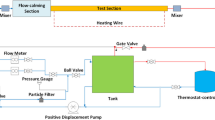Abstract
We describe how outer flow turbulence phenomena depend on the interaction with the wall. We investigate coherent structures in turbulent flows over different wavy surfaces and specify the influence of the different surface geometries on the coherent structures. The most important contribution to the turbulent momentum transport is attributed to these structures, therefore this flow configuration is of large engineering interest. In order to achieve a homogeneous and inhomogeneous reference flow situation two different types of surface geometries are considered: (1) three sinusoidal bottom wall profiles with different amplitude-to-wavelength ratios of α = 2a/Λ = 0.2 (Λ = 30 mm), α = 0.2 (Λ = 15 mm), and α = 0.1 (Λ = 30 mm); and (2) a profile consisting of two superimposed sinusoidal waves with α = 0.1 (Λ = 30 mm). Measurements are carried out in a wide water channel facility (aspect ratio 12:1). Digital particle image velocimetry (PIV) is performed to examine the spatial variation of the streamwise, spanwise and wall-normal velocity components in three measurement planes. Measurements are performed at a Reynolds number of 11,200, defined with the half channel height h and the bulk velocity U B. We apply the method of snapshots and perform a proper orthogonal decomposition (POD) of the streamwise, spanwise, and wall-normal velocity components to extract the most dominant flow structures. The structure of the most dominant eigenmode is related to counter-rotating, streamwise-oriented vortices. A qualitative comparison of the eigenfunctions for different sinusoidal wall profiles shows similar structures and comparable characteristic spanwise scales Λ z = 1.5 H in the spanwise direction for each mode. The scale is observed to be slightly smaller for α = 0.2 (Λ = 15 mm) and slightly larger for α = 0.2 (Λ = 30 mm). This scaling for the flow over the basic wave geometries indicates that the size of the largest structures is neither directly linked to the solid wave amplitude, nor to the wavelength. The characteristic spanwise scale of the dominant eigenmode for the developed flow over the surface consisting of two superimposed waves reduces to 0.85 H. However, a scale in the order of 1.3 H is identified for the second mode. The eigenvalue spectra for the superimposed waves is much broader, more modes contribute to the energy-containing range. The turbulent flow with increased complexity of the bottom surface is characterized by an increased number of dominant large-scale structures with different spanwise scales.








Similar content being viewed by others
References
Adrian RJ (1991) Particle-imaging techniques for experimental fluid mechanics. Annu Rev Fluid Mech 23:261–304
Berkooz G, Holmes P, Lumley JL (1993) The proper orthogonal decomposition in the analysis of turbulent flows. Annu Rev Fluid Mech 25:539–575
Brooke JW, Hanratty TJ (1993) Origin of turbulence-producing eddies in a channel flow. Phys Fluids A5(4):1011–1022
Cherukat P, Na Y, Hanratty TJ, McLaughlin JB (1998) Direct numerical simulation of a fully developed turbulent flow over a wavy wall. Theoret Comp Fluid Dynam 11:109–134
Görtler H (1940) Über eine dreidimensionale Instabilität laminarer Grenzschichten an konkaven Wänden. Nachr Ges Wiss Göttingen, Math-Phys Klasse Neue Folge I 2:1–26
Günther A, Rudolf von Rohr P (2003) Large-scale structures in a developed flow over a wavy wall. J Fluid Mech 478:257–285
Kruse N (2005) Isothermal and non-isothermal turbulent flow over solid waves. PhD thesis, ETH Zurich, Switzerland, Url http://www.e-collection.ethbib.ethz.ch/show?type=diss&nr= 16031
Kruse N, Günther A, Rudolf von Rohr P (2003) Dynamics of large-scale structures in turbulent flow over a wavy wall. J Fluid Mech 485:87–96
Kruse N, Kuhn S, Rudolf von Rohr P (2006) Wavy wall effects on turbulence production and large-scale modes. J Turbulence 7(31):1–24
Phillips WRC, Wu Z (1994) On the instability of wave-catalysed longitudinal vortices in strong shear. J Fluid Mech 272:235–254
Phillips WRC, Wu Z, Lumley JL (1996) On the formation of longitudinal vortices in a turbulent boundary layer over wavy terrain. J Fluid Mech 326:321–341
Raffel M, Willert C, Kompenhans J (1998) Particle image velocimetry. A practical guide. Springer, Heidelberg
Saric WS (1994) Görtler vortices. Annu Rev Fluid Mech 26:379–409
Scarano F (2002) Iterative image deformation methods in PIV. Meas Sci Technol 13:R1–R19
Scarano F, Riethmuller ML (2000) Advances in iterative multigrid PIV image processing. Exp Fluids 29:S51–S60
Sirovich L (1987) Turbulence and the dynamics of coherent structures. Part I. Coherent structures. Q Appl Math XLV:561–571
Westerweel J (1997) Fundamentals of digital particle image velocimetry. Meas Sci Technol 8:1379–1392
Westerweel J, van Oord J (2000) Stereoscopic PIV measurements in a turbulent boundary layer. In: Stanislas M, Kompenhans J, Westerweel J (eds) Particle image velocimetry, progress toward industrial application. Kluwer, Dordrecht
Acknowledgment
We gratefully acknowledge financial support from the Swiss National Science Foundation (SNF). Measurement technology is partially provided by ILA GmbH.
Author information
Authors and Affiliations
Corresponding author
Rights and permissions
About this article
Cite this article
Kuhn, S., Wagner, C. & Rudolf von Rohr, P. Influence of wavy surfaces on coherent structures in a turbulent flow. Exp Fluids 43, 251–259 (2007). https://doi.org/10.1007/s00348-007-0262-x
Received:
Revised:
Accepted:
Published:
Issue Date:
DOI: https://doi.org/10.1007/s00348-007-0262-x




